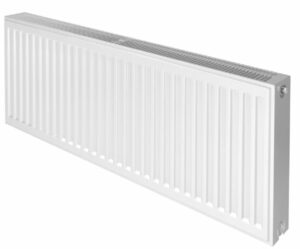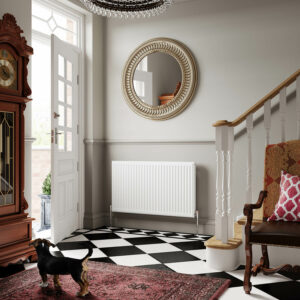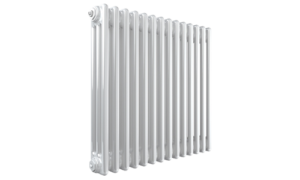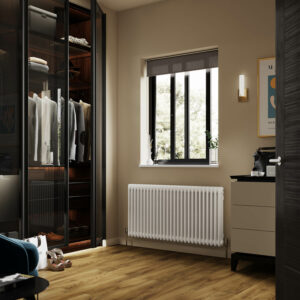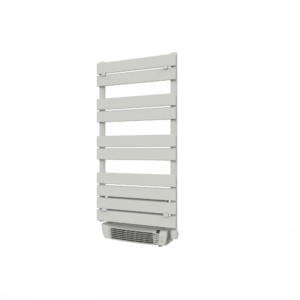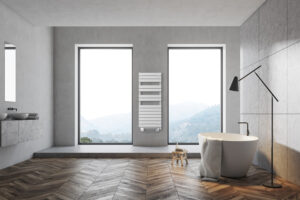Have you ever wondered why some rooms feel cosier than others, despite similar décor? Often, the secret lies not just in the furniture or colour scheme, but in something as practical as the choice of radiator. Choosing the right radiator size can transform your space from just okay to absolutely perfect, so focusing on radiator sizing before purchase is a crucial yet frequently overlooked aspect of home comfort.
Below, we’ll look at the essentials of calculating the correct radiator size so that you can know how to measure your space effectively, ensuring that your radiator not only heats efficiently but also enhances the overall look and feel of your room.
Whether you’re refurbishing your kitchen or bedroom or simply keen on improving your home heating system, radiator sizing is key. At Stelrad, we have hundreds of radiators suitable for all types of property in multiple dimensions, so once you know the size you need, you can easily order online.
Calculating The Right Size Space For Your Radiator
The size of your radiator is more than just a matter of space when it comes to your home heating – it’s about ensuring maximum comfort and efficiency. Having a radiator that’s too small won’t heat your room effectively, leaving it chilly and unwelcoming. On the other hand, an oversized radiator can lead to unnecessary energy consumption and higher bills. That’s why getting the size just right is essential.
Why it’s important to calculate the right size and measuring space for radiators:
- Energy Efficiency – The right-sized radiator operates at peak efficiency. This means it uses less energy to heat your room, which is not only good for your bank balance but also the environment.
- Optimal Heat Distribution – A radiator that fits the space perfectly distributes heat more evenly, eliminating cold spots and ensuring a consistent temperature throughout the room.
- Aesthetic Balance – The size of your radiator should complement the dimensions of your room. A radiator that’s too large or too small can disrupt the visual harmony of your space.
Calculating the right size and space for your radiator involves considering the dimensions of your room, the type of insulation, window sizes, and even the number of doors. Think of it as a blend of science and art – you’re calculating for efficiency while considering the design of your space.
What To Consider When Measuring For A Radiator
Selecting the right radiator for your space isn’t just about the numbers, but also understanding how it will fit into the overall feel and functionality of your room. Here’s what to consider:
Room Dimensions – Start with the basics, and that means accurately measuring the length, width, and height of your room. These measurements will be crucial in determining the radiator’s heat output required to warm your space adequately.
Insulation Quality – Think about the existing insulation of your room. Older buildings with poor insulation may require radiators with higher heat output compared to well-insulated, modern constructions.
Window Size and Type – Large windows or double-glazing can impact how much heat is lost. Bigger windows often mean more heat loss, which may mean you will require a radiator with larger heat output, such as a K2 double panel radiator or K3 triple panel radiator.
Room Use – Think about the room’s purpose and whether it is a room in constant or little use. A bathroom or a kitchen, for instance, might require more heat compared to a bedroom or a home office.
Aesthetics and Placement – The radiator should complement your room’s design and not look out of place. Consider the style as well as size and whether a horizontal or vertical radiator would suit your space better. Placement is key for both performance and design, with a radiator under a window able to counteract heat loss, but you may require a smaller radiator to fit underneath. In a large room, you may want to consider other wall options.
Existing Furniture – Ensure your chosen radiator size fits in with the room and doesn’t obstruct any furniture or foot traffic.
Measuring space for radiators whilst considering the rest of the room will help you determine whether your chosen style will fit. Fitting a wall-mounted electric radiator will have different considerations compared to horizontal column radiators, for example, so being completely sure about the radiator sizing and how this will look in the room before purchase is recommended.
Tips To Measure Correctly
As you will want to get the size and heat output exactly right, here are some tips to help you measure your space accurately:
- Use a Reliable Measuring Tool – A tape measure is your best friend here, so measure the full length and height of the room accurately. It’s important to get the full room measurement and not just the space where you want the radiator to go.
- Measure Twice – Just to be sure, always measure at least twice to avoid any errors. Small miscalculations can lead to big issues when it comes to radiator sizing.
- Consider the BTU (British Thermal Unit) – The heat output of radiators is measured in BTUs. You can use a BTU calculator to determine the BTU requirement for your room. Once you have your room measurements, you can input this into the calculator along with details about the room such as the number of windows, and insulation levels. Using the calculator will make choosing a radiator much simpler. You can also use our radiator size calculator if you know the exact dimensions of the radiator you require, such as when replacing older radiators for the same size.
- Think About Radiator Style – The style of the radiator can affect its heating efficiency. For instance, column radiators may have a different heat output compared to flat front panel radiators of the same size. Our BTU calculator can help with this.
- Consult a Professional – If of course you’re not sure, it’s always wise to consult a heating engineer. They can provide expert advice and ensure you’re making the right decision.
If you follow the above, you’re well on your way to measuring your space for radiators that are both efficient and aesthetically pleasing.
Buying The Right Size For Your Space
Now that you’ve measured your space accurately, and calculated the required BTU you need, it’s time to choose the right radiator. Here are some key points to consider:
- Don’t Overpower Your Space – A common misconception is that bigger radiators always provide better heating. However, an oversized radiator can make temperature control difficult and could lead to wasted energy. It’s best to find a balance between size and heat output and use our BTU calculator for recommendations.
- Consider Different Types – Radiators come in various types and styles. Vertical radiators can be a great space-saving solution in smaller rooms or areas with limited wall space like a kitchen. Horizontal radiators are a classic design, and they suit a variety of spaces.
- Material Matters – The material of the radiator affects how quickly it heats up and cools down. Cast iron models take longer to heat up but retain heat for longer, for example, but steel has always been a popular choice thanks to its durability and heating performance.
- Aesthetic Integration – Choose a radiator that complements the room’s design. Modern interiors might benefit from sleek, contemporary radiator designs, while traditional spaces may suit more classic styles.
- Installation and Maintenance – Consider the installation process and long-term maintenance. Ensure that your chosen radiator is compatible with your current heating system and easy to maintain.
Overall, buying the right size radiator for your space is about balancing practicality with design. A well-chosen radiator not only efficiently heats your room but also enhances its overall look and feel.
Remember, the right radiator can make a world of difference in creating a warm, inviting, and stylish home, and we have plenty to choose from including electric radiators here at Stelrad. To find out more or if you require help with choosing the right size, please contact us. Please visit our blog to discover more radiator advice and tips, including innovations in radiator technology and how to position a radiator for efficient heating.


